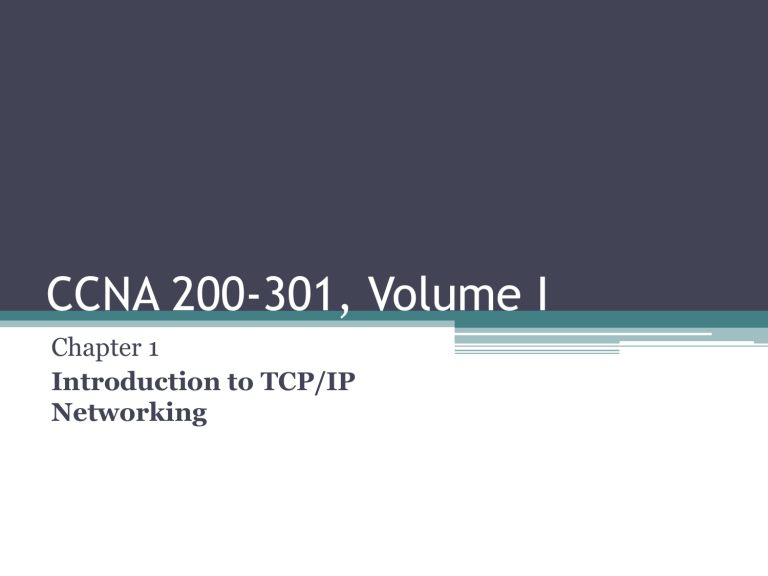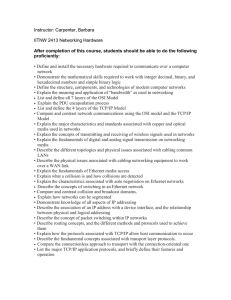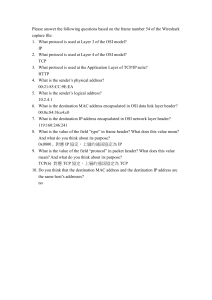
CCNA 200-301, Volume I Chapter 1 Introduction to TCP/IP Networking Objectives • Perspective on Networking • TCP/IP Networking Model • Data Encapsulation Terminology Two Major Branches of Networking Enterprise Network TCP/IP Networking Model Historical Progression: Proprietary Models to Open TCP/IP The Two TCP/IP Networking Models TCP/IP Architectural Model and Example Protocols TCP/IP Architecture Layer Example Protocols Application HTTP, POP 3, SMTP Transport TCP,UDP Internet IP, ICMP Data Link & Physical Ethernet, 802.11 (Wi-Fi) TCP/IP HTTP Basic Application Logic to Get a Web Page HTTP (continued) HTTP Get Request, HTTP Reply, and one Data-Only Message TCP/IP Transport Layer TCP Error-Recovery Services as Provided to HTTP Same-Layer and Adjacent-Layer Interaction Postal Service Forwarding (Routing) Letters Simple TCP/IP Network Basic Routing Example Ethernet Larry Using Ethernet to Forward an IP Packet to Router R1 Five Steps of Data Encapsulation: TCP/IP The letters LH and LT stand for link header and link trailer, respectively, and refer to the data link layer header and trailer. Perspective on Encapsulation and “Data” The letters LH and LT stand for link header and link trailer, respectively, and refer to the data link layer header and trailer. OSI Networking Model OSI Model Compared to the Two TCP/IP Models OSI Reference Model Layer Definitions Layer Functional Description 7 Application layer. This layer provides an interface between the communications software and any applications that need to communicate outside the computer on which the application resides. It also defines processes for user authentication. All 6 People 5 4 Presentation layer. This layer’s main purpose is to define and negotiate data formats, such as ASCII text, EBCDIC text, binary, BCD, and JPEG. Encryption is also defined by OSI as a presentation layer service Seem Session layer. This layer defines how to start, control, and end conversations (called sessions). This includes the control and management of multiple bidirectional messages so that the application can be notified if only some of a series of messages are completed. This allows the presentation layer to have a seamless view of an incoming stream of data. To Transport layer. This layer’s protocols provide a large number of services, as described in Chapter 5, “Fundamentals of TCP/IP Transport and Applications.” Although OSI Layers 5 through 7 focus on issues related to the application, Layer 4 focuses on issues related to data delivery to another computer (for instance, error recovery and flow control). OSI Reference Model Layer Definitions (Continued Layer Functional Description 3 Need Network layer. This layer defines three main features: logical addressing, routing (forwarding), and path determination. Routing defines how devices (typically routers) forward packets to their final destination. Logical addressing defines how each device can have an address that can be used by the routing process. Path determination refers to the work done by routing protocols to learn all possible routes, and choose the best route. 2 Data Data link layer. This layer defines the rules that determine when a device can send data over a particular medium. Data link protocols also define the format of a header and trailer that allows devices attached to the medium to successfully send and receive data 1 Processing Physical layer. This layer typically refers to standards from other organizations. These standards deal with the physical characteristics of the transmission medium, including connectors, pins, use of pins, electrical currents, encoding, light modulation, and the rules for how to OSI Reference Model Example Devices and Protocols Layer Name Protocols and Specifications Devices Application, presentation, session (Layers 5–7) Telnet, HTTP, FTP, SMTP, Hosts, firewalls POP3, VoIP, SNMP Transport (Layer 4) TCP, UDP Hosts, firewalls Network (Layer 3) IP Router Data link (Layer 2) Ethernet (IEEE 802.3), HDLC LAN switch, wireless access point, cable modem, DSL modem Physical (Layer 1) RJ-45, Ethernet (IEEE 802.3) LAN hub, LAN repeater, cables OSI Encapsulation and Protocol Data Units





